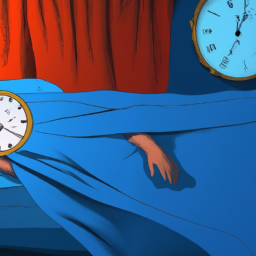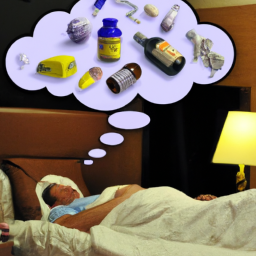Lucid Dreaming Techniques
The Vivid Dreams Stage Of Sleep Occurs At Which Point?

Have you ever woken up from a dream that felt so real, it left you questioning the boundaries of reality? The stage of sleep where such vivid dreams occur is a fascinating phenomenon that captivates scientists and dream enthusiasts alike. In this article, we will delve into the depths of this enigmatic stage, exploring its timing and characteristics.
Like a hidden treasure waiting to be discovered, the vivid dreams stage of sleep unveils itself during a specific phase known as REM sleep. REM, or Rapid Eye Movement, is a period when our eyes dart back and forth beneath our closed eyelids. It is during this stage that our dreams come alive, painting vivid landscapes and narratives that seem to defy the laws of the waking world.
But why are some dreams more vivid than others? And what role does REM sleep play in memory consolidation? We will explore these questions and more, as we unravel the mysteries of the sleeping mind.
So, get ready to embark on a journey into the realm of dreams, where reality and imagination intertwine, and the vivid dreams stage awaits.
Key Takeaways
- The vivid dreams stage of sleep occurs during REM sleep.
- Approximately 20-25% of total sleep time is spent in REM sleep.
- The REM stage of sleep becomes longer throughout the night.
- Sleep deprivation disrupts REM sleep and can result in fragmented dreams or a lack of dreams.
The Stages of Sleep
The vivid dreams stage of sleep occurs during REM (rapid eye movement) sleep. REM sleep is one of the five stages of sleep that our bodies go through in a regular sleep cycle. Each stage has its own distinct features and functions.
During REM sleep, our brain activity increases, and our eyes move rapidly from side to side. This stage is characterized by vivid dreams and increased brain activity.
Sleep deprivation has a significant impact on brain function. When we don’t get enough sleep, our cognitive abilities, such as memory, attention, and decision-making, can be impaired. Sleep disorders, such as insomnia or sleep apnea, can also disrupt the stages of sleep, including REM sleep.
These disorders can result in fragmented sleep, leading to a lack of proper REM sleep and potentially affecting our ability to dream vividly.
As we transition into the subsequent section about REM sleep, it is important to understand the significance of this stage in our sleep cycle. REM sleep is not only associated with vivid dreams but also plays a crucial role in memory consolidation and emotional processing. It’s a fascinating stage of sleep that warrants further exploration.
REM Sleep
During REM sleep, the mind takes flight in a world of fantastical visions that can leave us feeling both exhilarated and perplexed. This stage of sleep is characterized by rapid eye movement and is often referred to as REM sleep. It is during this time that our most vivid and memorable dreams occur. Dream research has shown that the brain is highly active during REM sleep, with increased activity in areas associated with emotions, memory, and visual processing.
To better understand the experience of REM sleep, let’s imagine a scene in which the mind becomes a canvas for an array of colorful and surreal images. In the first column of the table, we see a soaring dragon breathing fire and a majestic waterfall cascading down a lush green mountain. In the second column, a unicorn gallops across a field of flowers, while a spaceship zooms through a starry sky. These images represent the vivid and imaginative nature of our dreams during REM sleep.
As we delve further into the connection between REM sleep and dreams, we will explore the fascinating ways in which our subconscious mind constructs these elaborate narratives and how they may relate to our waking experiences.
The Connection Between REM Sleep and Dreams
Imagine yourself in a magical realm where your wildest fantasies come to life as your mind takes flight during REM sleep. During this stage of sleep, the brain becomes highly active, and dreams occur.
The connection between REM sleep and dreams has fascinated scientists for decades. Researchers have found a strong correlation between the intensity of REM sleep and the vividness of dreams.
-
The Relationship between REM Sleep and Mental Health: Studies have shown that individuals who experience disrupted REM sleep are more likely to develop mental health disorders such as depression and anxiety. This suggests that the quality of our dreams during REM sleep may play a crucial role in maintaining our mental well-being.
-
The Impact of Sleep Disorders on Dream Recall: Sleep disorders such as insomnia or sleep apnea can disrupt the normal sleep cycle, including REM sleep. As a result, individuals with these disorders may have difficulty recalling their dreams. This lack of dream recall can further impact their mental health and overall sleep quality.
-
The Vividness of Dreams in REM Sleep: The dreams experienced during REM sleep are often incredibly vivid and lifelike. Colors appear more vibrant, emotions are heightened, and the dream scenarios can be incredibly detailed. This heightened level of realism during REM sleep may contribute to the emotional impact dreams can have on individuals.
As we delve further into the topic of the vividness of dreams in REM sleep, we will explore the mechanisms behind this phenomenon.
The Vividness of Dreams in REM Sleep
Picture yourself transported to a fantastical realm where your mind takes flight and the extraordinary becomes your reality as you delve into the magical world of REM sleep. During this stage of sleep, also known as Rapid Eye Movement sleep, our dreams become vivid and surreal, as if we’re living in an alternate reality.
The vividness of dreams experienced in REM sleep is a fascinating phenomenon that has captivated scientists and dream enthusiasts alike. Dream symbolism plays a significant role in understanding the meaning behind our dreams. As we journey through the realm of REM sleep, our subconscious mind expresses itself through symbols and metaphors. These symbols often hold deep meaning and can provide valuable insights into our unconscious thoughts, desires, and fears.
Dream analysis, a field of study that explores the significance of these symbols, helps to unravel the hidden messages within our dreams. As we transition into the subsequent section about the role of REM sleep in memory consolidation, it’s important to note that the vividness of dreams experienced during this stage isn’t merely random or meaningless. Our dreams serve a purpose, providing a space for our minds to process and consolidate memories, emotions, and experiences. Understanding the intricate relationship between REM sleep and memory consolidation is crucial in unraveling the mysteries of the dreaming mind.
The Role of REM Sleep in Memory Consolidation
To understand the role of REM sleep in memory consolidation, you may find it fascinating that studies have shown that approximately 20-25% of our total sleep time is spent in this stage. During REM sleep, the brain is highly active, and this is when we experience vivid dreams. The role of REM sleep in memory consolidation is still being researched, but it is believed that this stage of sleep plays a crucial role in processing and storing information.
One way to measure the impact of dream recall on dream interpretation is through the use of dream journals. By recording our dreams upon waking, we can better understand the content and emotional aspects of our dreams. This can provide insight into our subconscious thoughts and feelings, as well as help us identify patterns or recurring themes in our dreams.
To further explore the topic of dreams, the next section will delve into the phenomenon of lucid dreaming. In this state, individuals are aware that they are dreaming and can actively participate and control the dream narrative. Lucid dreaming opens up a whole new realm of possibilities for studying and understanding the mysteries of the dreaming mind.
Lucid Dreaming
Lucid dreaming is a fascinating phenomenon where one becomes aware that they’re dreaming while still in the dream state. During a lucid dream, the dreamer has the ability to control and manipulate the events and experiences within the dream.
Techniques to induce lucid dreaming include reality testing, where one regularly questions their waking state throughout the day, and the use of mnemonic devices, such as repeating a phrase like "I’ll remember I’m dreaming" before going to sleep.
Lucid dreaming offers a unique opportunity for researchers to explore the boundaries of consciousness and the potential applications of lucid dreaming for personal growth and therapeutic purposes.
Definition and explanation of lucid dreaming
During the vivid dreams stage of sleep, individuals experience a profound and immersive dream world that feels incredibly real.
Lucid dreaming is a phenomenon where the dreamer becomes aware that they are dreaming while still in the dream state. This awareness allows the dreamer to control and manipulate their dreams, leading to a unique and exhilarating experience.
Many people are interested in lucid dreaming and there are several techniques that can help induce it. Some common tips for lucid dreaming include reality checks throughout the day, keeping a dream journal, and practicing meditation before sleep. Additionally, certain dream symbols, such as flying or being able to breathe underwater, can act as triggers for lucid dreaming.
By understanding and utilizing these techniques, individuals can actively engage in and explore their dreams.
Transitioning into the subsequent section about techniques to induce lucid dreaming, it is important to explore further methods that can enhance this extraordinary experience.
Techniques to induce lucid dreaming
In the realm of lucid dreaming, there are various techniques that can be employed to induce this extraordinary experience. These techniques include keeping a dream journal and practicing reality checks. To induce control and dream manipulation during lucid dreams, there are several effective techniques to try:
-
MILD (Mnemonic Induction of Lucid Dreams): This technique involves repeating a mantra, such as ‘I’ll have a lucid dream tonight,’ before falling asleep.
-
WILD (Wake-Induced Lucid Dreaming): This technique involves maintaining awareness while transitioning from wakefulness to sleep, allowing for a seamless entry into a lucid dream.
-
Reality Checks: Performing reality checks throughout the day, such as looking at your hands and asking if you’re dreaming, can help trigger lucidity within dreams.
-
Dream Supplements: Certain substances, like galantamine or choline, have been reported to increase the likelihood of having lucid dreams.
By employing these techniques, you can enhance your ability to induce control and manipulate your dreams.
Transitioning into the subsequent section about factors that influence dream vividness, it’s important to explore the various aspects that contribute to the intensity of our dream experiences.
Factors That Influence Dream Vividness
While we snooze away, the stage of sleep where our dreams come to life is when the magic truly happens. Factors influencing dream vividness are closely tied to the sleep cycle.
One important factor is the rapid eye movement (REM) stage of sleep, which is when most vivid dreaming occurs. During REM sleep, our brains become highly active and our eyes move rapidly beneath our closed eyelids. This stage usually happens about 90 minutes after we fall asleep and can last for about 10 minutes initially, but becomes longer throughout the night. The lengthening of REM sleep throughout the night is one reason why dreams tend to be more vivid in the early morning hours.
Other factors that can influence dream vividness include lifestyle choices, such as stress levels, alcohol or drug use, and sleep quality. Stress and anxiety can increase the likelihood of vivid dreams, as can certain medications or substances that affect brain activity. Additionally, getting enough sleep and having a regular sleep schedule can also contribute to more vivid dreams.
As we explore the factors that influence dream vividness, we can start to unravel the mysteries of our subconscious minds. Dream interpretation allows us to delve deeper into the meanings behind these vivid experiences, offering us a glimpse into our inner thoughts and emotions.
Dream Interpretation
Dream interpretation allows us to unlock the hidden messages and symbolism within our nightly journeys into the depths of our subconscious minds. By analyzing the symbols and themes present in our dreams, we can gain a deeper understanding of ourselves and our inner thoughts.
Dream symbolism is a key aspect of interpretation, as it involves deciphering the meaning behind the various objects, people, and situations that appear in our dreams. These symbols can be highly personal and subjective, but there are also common dream themes that many people experience.
In my research, I’ve found that common dream themes include falling, flying, being chased, and being naked in public. Each of these themes can represent different emotions or experiences in our waking lives. For example, falling may symbolize a loss of control or a fear of failure, while flying can represent a sense of freedom or empowerment. Being chased may indicate feelings of anxiety or a need to confront a difficult situation, and being naked in public may reflect vulnerability or a fear of judgment.
Understanding the symbolism and themes in our dreams can provide valuable insights into our inner thoughts and emotions. By exploring these hidden messages, we can gain a deeper understanding of ourselves and our subconscious minds.
Note: The subtopic transition was added in the last sentence to connect the current subtopic with the subsequent section.
Techniques to Enhance Dream Recall
When it comes to enhancing dream recall, there are a few key techniques that I find helpful. First, I make it a priority to write down my dreams as soon as I wake up. This not only helps to solidify the memory of the dream, but it also allows me to analyze and interpret it later on. Keeping a dream journal has proven to be incredibly beneficial in understanding my subconscious mind and uncovering patterns or themes in my dreams.
Tips for remembering and recording dreams
To make the most of your dream-recording journey, try using these simple tips and tricks:
- Practice visualization techniques before bed to enhance dream recall.
- Keep a dream journal next to your bed to record your dreams immediately upon waking.
- Write down as much detail as possible, including emotions, colors, and sensory experiences.
- Use drawings or sketches to capture visual elements of your dreams.
- Reflect on the meaning and symbolism behind your dreams to gain insight into your subconscious mind.
Dream recall is a crucial step in the analysis of your dreams. By diligently recording and analyzing your dreams, you can uncover hidden patterns and gain a deeper understanding of yourself. Keeping a dream journal allows you to track your progress and make connections between your dreams and your waking life.
The benefits of keeping a dream journal
Keeping a dream journal allows me to delve into the depths of my subconscious mind and unlock the hidden treasures of self-discovery. Through dream analysis, I’m able to gain valuable insights into my thoughts, emotions, and desires that I may not be aware of in my waking life.
By recording my dreams in detail, I’m able to identify recurring patterns, symbols, and themes that can provide clues about my innermost thoughts and conflicts. The subconscious mind often communicates through symbols and metaphors, and by keeping a dream journal, I’m able to decipher these messages and gain a deeper understanding of myself.
It’s fascinating to explore the mysteries of the sleeping mind and uncover the rich tapestry of my inner world.
Transitioning into the next section, the vivid dreams stage of sleep occurs at a specific point that is crucial for further exploration.
Conclusion: Exploring the Mysteries of the Sleeping Mind
You may wonder about the mysteries of the sleeping mind, and one adage that comes to mind is ‘a dream is a window to the subconscious.’ Dreams have always fascinated scientists and researchers, as they offer a glimpse into the inner workings of our minds. Through exploring dream symbolism and the impact of sleep deprivation on dreaming, we can gain a deeper understanding of this enigmatic phenomenon.
To better understand the significance of dreams, it is important to explore the symbolism embedded within them. Dreams often contain symbols that represent our unconscious thoughts, desires, and fears. For example, dreaming about flying may symbolize a desire for freedom or a sense of empowerment. By interpreting these symbols, we can unlock hidden meanings and gain insight into our own psyche.
Sleep deprivation, on the other hand, can have a significant impact on our dreams. When we do not get enough sleep, our REM (Rapid Eye Movement) sleep, which is the stage where vivid dreams occur, becomes disrupted. This can result in fragmented dreams or even a complete lack of dreams. Additionally, sleep deprivation can also lead to an increase in nightmares, as our brain tries to compensate for the lack of restorative sleep.
Exploring the mysteries of the sleeping mind through dream symbolism and the impact of sleep deprivation on dreaming can provide valuable insights into our subconscious. Understanding the significance of our dreams can help us better understand ourselves and potentially improve our overall well-being.
| Dream Symbolism | Impact of Sleep Deprivation on Dreaming | Advantages of Keeping a Dream Journal |
|---|---|---|
| Unconscious thoughts, desires, fears | Disruption of REM sleep, fragmented dreams | Improved self-awareness, potential for personal growth |
| Symbols representing hidden meanings | Increase in nightmares | Enhanced understanding of subconscious |
| Unlocking insight into our own psyche | Lack of restorative sleep | Potential improvement in overall well-being |
Frequently Asked Questions
What are the different stages of sleep and how do they relate to the vivid dreams stage?
There are five stages of sleep: stage 1, stage 2, stage 3, stage 4, and REM (rapid eye movement) sleep. Each stage is characterized by different brain wave patterns and physiological changes.
Stage 1 is the transition from wakefulness to sleep, while stage 2 is a deeper sleep.
Stages 3 and 4 are deep sleep stages, also known as slow-wave sleep.
REM sleep, which is where vivid dreaming occurs, happens approximately 90 minutes after falling asleep and repeats throughout the night in cycles.
What is the connection between REM sleep and the occurrence of dreams?
During REM sleep, which stands for rapid eye movement, the brain is highly active and dreams occur. This stage of sleep is characterized by increased brain activity, similar to that of being awake. Studies have shown that the majority of dream content occurs during REM sleep. In fact, research suggests that about 80% of our dreams occur during this stage.
This connection between REM sleep and the occurrence of dreams highlights the importance of this sleep stage in our overall sleep experience.
How vivid are dreams during REM sleep compared to other stages of sleep?
During REM sleep, dreams are known to be extremely vivid and have a high level of intensity. This stage of sleep is characterized by rapid eye movements and increased brain activity. The dreams experienced during REM sleep are often more detailed, realistic, and emotionally charged compared to dreams in other stages of sleep.
The quality of these dreams can vary from person to person, but they’re generally considered to be more vivid and memorable.
What role does REM sleep play in memory consolidation?
REM sleep plays a crucial role in memory consolidation. During this stage, the brain processes and consolidates information, transferring it from short-term to long-term memory. This process is essential for learning and retaining new information.
Scientific research has shown that disruptions in REM sleep can impair memory consolidation and lead to difficulties in learning and remembering. Therefore, the role of REM sleep in memory consolidation is vital for optimal cognitive functioning.
Are there any techniques that can be used to enhance dream recall during the vivid dreams stage of sleep?
There are several techniques that can be utilized to enhance dream recall during the vivid dreams stage of sleep. One effective method is keeping a dream journal, where I record my dreams as soon as I wake up. This helps to strengthen the connection between my waking and dreaming worlds, making it easier to recall dreams in detail.
Another technique is practicing reality checks throughout the day, which increases self-awareness and improves dream recall ability.
Conclusion
In conclusion, the exploration of the mysteries of the sleeping mind is a truly fascinating endeavor. Through the stages of sleep, particularly REM sleep, we delve into a world of vivid dreams that can transport us to unimaginable realms.
The connection between REM sleep and dreams is a complex phenomenon that continues to captivate scientists and researchers alike. With factors such as memory consolidation and various influences on dream vividness, there is much to unravel in this enigmatic realm.
By utilizing techniques to enhance dream recall, we can unlock the secrets hidden within our own minds, unveiling a treasure trove of experiences and knowledge.
So, let us embark on this extraordinary journey of discovery, where reality and fantasy intertwine, and the sleeping mind unveils its extraordinary depths.
Eislyn is a gifted writer whose words weave enchanting narratives within the realm of dreams. With a profound love for storytelling and a deep curiosity about dreams, Eislyn’s articles transport readers into vivid dreamscapes.
Her writing style is both eloquent and thought-provoking, captivating readers’ imaginations and inspiring them to dive deeper into the mysteries of their own dreams. Eislyn’s exploration of dream symbolism and interpretation adds depth and nuance to our content, making it an absolute pleasure for dream enthusiasts to engage with.
Lucid Dreaming Techniques
How To Have More Dreams

Yes, I have definitely experienced the feeling of missing out on an adventure because I couldn’t recall my dreams.
Dreams are like a secret world, a place where we can explore our deepest desires and fears without any consequences. But what if I told you that there are ways to have more dreams and even control them? It’s like having a VIP pass to your own private amusement park.
Let’s dive into the science of dreams and discover how you can have more of them.
Dreams are like the ocean, vast and mysterious, yet full of treasures waiting to be discovered. However, sometimes the waves are too rough, and we can’t see what lies beneath. That’s where the tips and tricks in this article come in handy.
By understanding the science of dreams and implementing certain practices in your daily routine, you can increase the frequency, vividness, and control of your dreams.
So, put on your snorkeling gear, and let’s dive into the world of dreams.
Key Takeaways
- Keeping a dream journal can improve dream recall and identify recurring themes.
- Practicing relaxation techniques and managing stress can increase the chances of having vivid dreams.
- Experimenting with sleep positions and investing in comfortable bedding can stimulate the brain and increase dream frequency.
- Using lavender essential oil through aromatherapy can promote deeper, more restful sleep and enhance dream experiences.
Understand the Science of Dreams
You wanna know why you dream and how understanding the science behind it can help you have more vivid dreams? Let’s dive in!
Dreams occur during the REM (Rapid Eye Movement) phase of sleep, which happens about 90 minutes after you fall asleep and reoccurs every 90 minutes thereafter. During this phase, your brain is highly active, and your body is in a state of paralysis. This paralysis is a safety mechanism to prevent you from acting out your dreams physically.
Scientists believe that our dreams serve many purposes, such as consolidating memories, processing emotions, and problem-solving. By understanding the science behind dreams, you can learn how to optimize your sleep and have more vivid dreams.
So, let’s move on to the next step and learn how keeping a dream journal can help you remember more of your dreams.
Keep a Dream Journal
I personally find keeping a dream journal to be incredibly helpful in understanding my dreams. The benefits of journaling include improving dream recall, identifying recurring themes and symbols, and creating a space for self-reflection.
When recording your dreams, it’s important to include as much detail as possible, including emotions and physical sensations. By analyzing your dreams, you can gain insight into your subconscious thoughts and feelings.
The Benefits of Journaling
By regularly journaling your dreams, you can gain insight into your subconscious mind and potentially improve your overall well-being. Writing down your dreams as soon as you wake up can help you remember more details and make connections between your dreams and your waking life.
Additionally, keeping a dream journal can help you identify recurring themes or patterns in your dreams, which can provide valuable information about your thoughts and feelings.
The benefits of journaling extend beyond simply remembering your dreams. Writing down your thoughts and emotions can help you process and make sense of them, leading to a greater understanding of yourself. It can also serve as a way to reduce stress and anxiety by releasing pent-up emotions and promoting a sense of mindfulness.
With these benefits in mind, it’s clear that keeping a dream journal can not only help you have more vivid dreams, but also improve your mental and emotional well-being. So, how can you start recording your dreams?
How to Record Your Dreams
Like a detective collecting clues, I always make sure to jot down any details I remember about my dreams as soon as I wake up. This helps me to record my subconscious thoughts and keep track of any recurring themes or symbols.
Here are three tips for recording your dreams:
- Keep a journal or notepad by your bed – this will make it easy to write down any details you remember as soon as you wake up.
- Write in the present tense – this’ll help you to remember the dream more vividly.
- Don’t worry about writing in complete sentences or making sense – just jot down any details that come to mind.
By recording your dreams regularly, you’ll start to notice patterns and recurring themes. This can be helpful when it comes to analyzing your dreams and gaining insight into your subconscious mind.
Analyzing Your Dreams
To truly understand the meanings behind your dreams, you must dive deeper into the symbols and themes that appear and reflect on how they may relate to your waking life. One way to do this is by analyzing your dreams.
Take note of the prominent themes and symbols that appear in your dreams. Reflect on how they make you feel and what memories or experiences they bring up for you. You can use a dream journal to record these observations and patterns.
Analyzing your dreams can help you gain insight into your subconscious mind and your emotions. It can also help you identify patterns and themes that may be present in your waking life.
Once you have a better understanding of your dreams, you can use this knowledge to practice lucid dreaming. With lucid dreaming, you can take control of your dreams and explore your subconscious mind in a more intentional way.
Practice Lucid Dreaming
Want to experience the thrilling adventure of controlling your dreams? Start practicing lucid dreaming! Lucid dreaming is a technique that allows you to become aware that you are dreaming while you’re still asleep. This means that you can control your dreams and make them as exciting and adventurous as you want them to be.
To start practicing lucid dreaming, there are a few things you can do. One is to keep a dream journal and write down your dreams as soon as you wake up. This will help you become more aware of your dreams and will increase your chances of realizing that you’re dreaming.
Another technique is to do reality checks throughout the day, such as looking at your hands or a clock and asking yourself if you’re dreaming. With practice, these habits will become second nature and you’ll be on your way to having more lucid dreams.
Now, let’s move on to improving your sleep habits.
Improve Your Sleep Habits
Improve your sleep habits by setting a regular bedtime and wake-up time. Remember the old adage, ‘early to bed, early to rise, makes a man healthy, wealthy, and wise.’
Here are some tips to help you improve your sleep habits and increase your chances of having more dreams:
- Avoid caffeine and alcohol before bedtime
- Keep your bedroom cool and dark
- Avoid using electronic devices at least an hour before bed
- Practice relaxation techniques before bed, such as meditation or deep breathing exercises
- Invest in a comfortable mattress and pillows
By following these tips, you can improve the quality of your sleep and increase the likelihood of having more dreams.
In the next section, we’ll discuss how certain foods and supplements can also enhance your dream experiences.
Use Dream-Enhancing Foods and Supplements
I’ve been working on improving my sleep habits, and it’s been helping me have more vivid dreams. But I wanted to take it a step further and try some dream-enhancing foods and supplements.
I did some research and found that certain foods and supplements can enhance your dreams, making them more vivid and memorable. One food that is said to enhance dreams is cheese. Specifically, cheddar cheese has been shown to increase the production of a neurotransmitter called acetylcholine, which is important for REM sleep and dreaming.
Additionally, there are supplements like vitamin B6 and melatonin that can aid in dream recall and promote more vivid dreams. I’m excited to try incorporating some of these foods and supplements into my diet and see if it makes a difference in my dream experiences.
Speaking of dream experiences, another technique for having more vivid dreams is visualization.
Try Visualization Techniques
You can enhance your dream experiences by incorporating visualization techniques into your routine, allowing you to fully immerse yourself in your dream world. Visualization involves creating detailed mental images of the dream you want to have, and focusing your thoughts on specific details or scenarios.
Here are some visualization techniques that have worked for me:
-
Create a dream scenario: Visualize a specific dream scenario that you want to experience, such as flying over a beautiful landscape or meeting a celebrity. Imagine the details of the scene, including the colors, sounds, and textures.
-
Use affirmations: Repeat positive affirmations to yourself, such as "I’ll have a vivid dream tonight"or "I’ll remember my dreams in the morning."This helps to set a positive intention for your dream experience.
By incorporating visualization techniques into your routine, you can increase your chances of having more vivid and memorable dreams. In addition to visualization, another way to enhance your dream experiences is to incorporate aromatherapy.
Incorporate Aromatherapy
I love using aromatherapy to help me have more vivid and meaningful dreams. One of the best ways to do this is by using essential oils for sleep and dreams.
There are a variety of ways to use aromatherapy for dreaming, but it’s important to take precautions and use these oils safely.
Essential Oils for Sleep and Dreams
Relax and let the soothing scent of lavender essential oil transport you to a peaceful night’s sleep filled with vivid and meaningful dreams. Lavender has been used for centuries as a natural remedy for sleep disorders and anxiety. It’s known for its calming and relaxing properties that promote deeper and more restful sleep.
In addition, lavender essential oil can enhance dream recall and promote lucid dreaming, allowing you to explore your subconscious mind and unlock hidden insights and creativity.
To use aromatherapy for dreaming, you can diffuse lavender essential oil in your bedroom before bedtime, add a few drops to a warm bath, or apply it topically to your pulse points. You can also mix lavender with other essential oils such as chamomile, ylang-ylang, or bergamot to create a customized blend that suits your needs and preferences.
Experiment with different oils and techniques to find what works best for you and enjoy a restful and rejuvenating night’s sleep filled with inspiring dreams.
How to Use Aromatherapy for Dreaming
Transform your nighttime routine with the power of aromatherapy and experience the wonders of lucid dreaming and enhanced dream recall using essential oils like lavender, chamomile, ylang-ylang, and bergamot.
To use aromatherapy for dreaming, you can add a few drops of essential oil to a diffuser or a cotton ball and place it next to your pillow. As you inhale the soothing scent, focus on your intention to have a vivid dream or a lucid dream.
You can also apply diluted essential oils to your temples, neck, or wrists before sleep to promote relaxation and stimulate dream activity.
However, it’s important to take precautions and ensure safety when using essential oils for aromatherapy. Always use high-quality, pure essential oils and avoid using too much oil.
Some essential oils may cause skin irritation or allergic reactions, so it’s recommended to do a patch test before using them on your skin. Additionally, if you’re pregnant, nursing, or have any medical conditions, consult with a healthcare professional before using essential oils.
With these precautions in mind, you can enjoy the benefits of aromatherapy for dreaming and enhance your dream experience.
Precautions and Safety
I hope you found the previous subtopic about using aromatherapy for dreaming helpful. Before you start using essential oils for your dreams, it’s important to take precautions and consider your safety.
Firstly, make sure you’re not allergic to any of the oils you plan to use. Test a small amount on your skin before applying it to your pillow or diffuser. Additionally, avoid using oils that may be harmful to pregnant women, children, or pets.
Always follow the instructions on the label and never ingest essential oils. By taking these precautions, you can safely enjoy the benefits of aromatherapy for dreaming.
Now, let’s move on to the next step in having more dreams: reducing stress and anxiety.
Reduce Stress and Anxiety
By managing stress and anxiety, I’ve been able to increase my chances of having more vivid and memorable dreams. When I’m feeling more relaxed, my mind is able to wander and explore new ideas during sleep.
To reduce stress and anxiety, I make sure to practice healthy habits such as exercise, meditation, and deep breathing techniques. I also try to limit my exposure to screens before bed, as the blue light can disrupt my sleep patterns and increase my overall stress levels.
When it comes to exploring different sleep positions, there are many options to consider. One technique that has worked well for me is sleeping on my left side. This position can help with digestion and reduce acid reflux, allowing for a more restful night’s sleep.
Additionally, sleeping on my back with a pillow under my knees has helped alleviate any lower back pain and has improved my overall comfort during sleep. By experimenting with different sleep positions, you may find what works best for you and ultimately enhance your dream experience.
Experiment with Different Sleep Positions
Hey, you might want to try out different sleep positions if you want to enhance your dream experience. I’ve found that changing my sleep position can sometimes lead to more vivid dreams.
When we sleep in the same position every night, our brains become accustomed to that routine and may not generate as many dreams. By switching up our sleeping position, we can stimulate our brains and increase our chances of having more dreams.
There are a variety of sleep positions you can try, such as sleeping on your back, stomach or side. Personally, I find that sleeping on my side with a pillow between my legs helps me have more intense dreams.
It’s important to experiment with different positions and find what works best for you. So, give it a try and see if it makes a difference in your dream quality. And remember, patience and persistence are key in achieving more dreams.
Practice Patience and Persistence
Don’t get discouraged if you don’t see immediate results, practicing patience and persistence is crucial in achieving a fulfilling dream experience. It takes time and effort to train your brain to remember and recall dreams more frequently.
Here are a few tips to help you stay patient and persistent in your pursuit of more dreams:
-
Keep a dream journal: Writing down your dreams as soon as you wake up can help you remember them more vividly. Make it a habit to jot down any details you can recall, even if it’s just a fleeting image or feeling. Over time, you may notice patterns or themes in your dreams that can help you better understand your subconscious.
-
Create a bedtime routine: Establishing a consistent bedtime routine can signal to your brain that it’s time to wind down and get ready for sleep. This can include activities like reading, meditation, or taking a warm bath. By sticking to a routine, you may find it easier to fall asleep and have more restful sleep overall.
-
Set realistic goals: Don’t expect to have a lucid dream or vivid dream every night right away. Start with small goals, like remembering one dream per week, and work your way up from there. Celebrate your successes along the way, and don’t be too hard on yourself if you have setbacks. Remember, patience and persistence are key!
Frequently Asked Questions
Can I have more than one dream in a night?
Yes, I often have multiple dreams in a night. It’s normal to have several dreams during the REM cycle. Keeping a dream journal and practicing good sleep habits can help increase dream recall and frequency.
Is it possible to control the length of my dreams?
I once heard that dreams are like movies, and just like movies, we can’t always control the length. However, practicing lucid dreaming techniques can increase the likelihood of longer dreams.
Can certain medications affect my ability to dream?
Yes, certain medications such as antidepressants and sleep aids can affect the ability to dream. They may also affect the content and vividness of dreams. Consult with a healthcare provider for more information.
Are there any negative side effects of lucid dreaming?
Lucid dreaming is amazing! However, I have experienced sleep paralysis and nightmares when I don’t control my dreams properly. It’s important to learn the practice and know your limits to avoid negative side effects.
How long does it typically take to see results from dream-enhancing supplements?
I’ve found that it varies depending on the supplement and the individual. Some people may see results within a few days, while others may take a few weeks. It’s important to follow the instructions and be patient.
Conclusion
So there you have it, folks – my personal tips on how to have more dreams!
By understanding the science behind dreams, keeping a dream journal, practicing lucid dreaming, improving your sleep habits, using dream-enhancing foods and supplements, incorporating aromatherapy, reducing stress and anxiety, experimenting with different sleep positions, and practicing patience and persistence, you can unlock a whole new world of dreaming.
Trust me, it’s worth it. Dreams can be a source of inspiration, creativity, and even problem-solving. Plus, they’re just plain fun!
So don’t give up if you don’t see results right away – keep trying different techniques and don’t be afraid to mix and match. Who knows – you may just have the most vivid, fantastical dream of your life tonight.
It’s not like you have anything to lose, right? Sweet dreams, everyone!
Eislyn is a gifted writer whose words weave enchanting narratives within the realm of dreams. With a profound love for storytelling and a deep curiosity about dreams, Eislyn’s articles transport readers into vivid dreamscapes.
Her writing style is both eloquent and thought-provoking, captivating readers’ imaginations and inspiring them to dive deeper into the mysteries of their own dreams. Eislyn’s exploration of dream symbolism and interpretation adds depth and nuance to our content, making it an absolute pleasure for dream enthusiasts to engage with.
Lucid Dreaming Techniques
What Does Dreams Real Face Look Like

I have always been intrigued by dreams. There is a certain mysterious and enigmatic quality about them that sparks my curiosity. Dreams serve as a gateway to our subconscious, allowing us to delve into our innermost fears, desires, and emotions.
But have you ever wondered what a dream’s real face looks like?
In this article, I’ll delve into the science behind dreams, explore their meaning and importance, and provide tips on how to control and improve your dreaming experience. Whether you’re someone who loves to analyze their dreams or simply curious about what they mean, join me on this journey to discover what a dream’s real face really looks like.
Key Takeaways
- Dreams are a mysterious and enigmatic window into our unconscious mind that are created during REM sleep.
- Dreams can be influenced by a variety of factors, including daily experiences, emotions, unresolved conflicts, and deepest fears and desires.
- Lucid dreaming, or the ability to become aware and control the narrative of one’s dreams, can be developed through practice and training.
- Dream journaling, cultivating a dream-friendly environment, and maintaining a positive mindset before bed can all help improve the quality of our dreams and offer insight into our innermost thoughts and desires.
The Science Behind Dreams
You’re probably wondering why your dreams seem so real, and that’s because your brain is actually working hard to create a vivid experience for you while you sleep! According to scientific studies, when we dream, our brain activity is similar to when we are awake.
The difference is that the brain is more active during REM (Rapid Eye Movement) sleep, which is the time when we usually dream. During this stage, the brain is processing memories and emotions, and it creates images and scenarios that are often random and disconnected.
Dreams can be influenced by several factors, such as our daily experiences, thoughts, and emotions. For instance, if you watched a horror movie before going to bed, you might dream about monsters or ghosts. Similarly, if you’re stressed or anxious, you might have nightmares or recurring dreams.
However, dreams can also be creative and inspiring, and they can help us solve problems or generate new ideas. In the next section, I’ll explore the meaning of dreams and how they can reveal hidden aspects of our subconscious mind.
The Meaning of Dreams
Exploring the depths of our subconscious mind through the images we see while we sleep can offer insight into our innermost thoughts and desires, like a window into our soul. Dreams can have a variety of meanings depending on the individual’s personal experiences and beliefs.
Here are some possible interpretations of dreams:
- Dreams can reveal unresolved emotions or conflicts that we may be repressing in our waking life.
- Dreams can be a reflection of our current state of mind and can offer guidance to help us make decisions.
- Dreams can serve as a way to process and cope with traumatic events or experiences.
- Dreams can be a manifestation of our deepest fears and desires.
- Dreams can be a source of inspiration and creativity for artists, musicians, and writers.
By understanding the meaning behind our dreams, we can gain a better understanding of ourselves and our subconscious mind. This knowledge can also be used to control and manipulate our dreams, which is the next topic of discussion.
Controlling your dreams allows you to explore your subconscious mind even further and can also be used as a tool for personal growth and self-improvement.
Controlling Your Dreams
Take control of your dreams and unlock the potential of your subconscious mind to achieve personal growth and self-improvement. Did you know that it’s possible to control your dreams? Lucid dreaming, or the ability to become aware that you are dreaming and then control the dream’s narrative, is a skill that can be developed through practice and training. Once you gain control of your dreams, you can explore your subconscious mind and use the experience to improve your life in many ways.
To get started with lucid dreaming, you can use techniques like reality checks, dream journaling, and visualization exercises. Reality checks involve checking if you are dreaming by looking for signs that are out of place or impossible in the waking world, such as trying to fly or reading a book with gibberish text. Dream journaling involves writing down your dreams as soon as you wake up, which can help you remember them better and identify patterns. Visualization exercises can help you imagine yourself becoming lucid in a dream and practicing different scenarios. By taking control of your dreams, you can better understand yourself and your desires, which can help you achieve personal growth and happiness.
As you begin to harness the power of your dreams, it’s important to remember their significance in your life. Dreams can provide insight into your deepest fears, desires, and emotions, and can help you process difficult experiences. In the next section, we’ll explore the importance of dreams and how they can impact your mental health and well-being.
The Importance of Dreams
Imagine delving into the depths of your mind and discovering hidden thoughts and emotions through the vivid landscapes of your dreams. Dreams aren’t simply random images and sensations that occur during sleep. They’re a reflection of our subconscious mind, a way for our brain to process and make sense of the events and emotions that we experience in our waking life.
Understanding the importance of dreams can lead to a greater understanding of ourselves. By paying attention to our dreams, we can gain insight into our deepest desires, fears, and motivations. Dreams can also provide us with creative inspiration, problem-solving skills, and even help us improve our memory.
With that in mind, let’s explore some tips for better dreaming.
Tips for Better Dreaming
I’ve always been fascinated by dreams and their mysterious nature. That’s why I’ve researched and experimented with different techniques to improve my dreams.
In this discussion, I’ll be sharing three tips that have helped me have better dreams: creating a dream-friendly environment, keeping a dream journal, and cultivating a positive mindset for better dreams.
Creating a Dream-Friendly Environment
To make your dreams more vivid, make sure you’re sleeping in a comfortable environment that’s free from distractions, such as noise and bright lights. Here are some tips for creating a dream-friendly environment:
- Keep your bedroom cool, between 60-67°F (15-19°C), as this temperature range has been found to be optimal for sleeping.
- Use comfortable bedding and pillows that support your preferred sleeping position.
- Keep your bedroom dark or use a sleep mask to block out any unwanted light.
By creating a relaxing and comfortable environment, you’ll be able to sleep more soundly and have a better chance of having vivid dreams. Keeping a dream journal is another great way to enhance your dream experience and gain better insight into your subconscious mind.
Keeping a Dream Journal
Keeping a dream journal is an effective way to track and analyze your dreams, providing insight into your subconscious mind and potentially unlocking hidden emotions and desires. By writing down your dreams as soon as you wake up, you can capture the details and emotions that might fade from memory as the day goes on.
As you continue to record your dreams, patterns may emerge, revealing recurring themes or symbols that can help you better understand your inner world. Furthermore, keeping a dream journal can also help you cultivate a positive mindset for better dreams.
By reflecting on your dreams and identifying any negative thought patterns or anxieties that may be affecting your sleep, you can work on addressing them and replacing them with more positive thoughts and emotions. This can lead to a more restful sleep and a more fulfilling dream life.
Cultivating a Positive Mindset for Better Dreams
I’ve been keeping a dream journal for a while now, and I’ve noticed that my dreams tend to be heavily influenced by my mindset before going to bed. If I go to bed feeling anxious or stressed, my dreams reflect those negative emotions. On the other hand, when I go to bed feeling positive and relaxed, my dreams tend to be more pleasant and uplifting.
This has led me to focus on cultivating a positive mindset before going to bed, in order to have better dreams. One thing that has helped me is practicing gratitude before bed. I take a few minutes to reflect on the things I’m grateful for in my life, and this helps me feel more positive and content.
I also try to avoid watching or reading anything that is violent or negative before bed, as this can influence my dreams in a negative way. By focusing on positivity and relaxation before bed, I’m able to have more pleasant dreams and wake up feeling refreshed and rejuvenated.
Frequently Asked Questions
Can dreams tell the future?
I don’t believe dreams can tell the future. While they can sometimes provide insights or reveal subconscious thoughts, they are ultimately just a product of our imagination and experiences.
Why do some people have recurring dreams?
I have recurring dreams because my subconscious is trying to tell me something important. It could be unresolved issues or fears that I need to address. Seeking therapy or practicing mindfulness can help break the cycle.
Do animals dream?
Do animals dream? As a scientist, I’ve studied the brain activity of various animals and have found evidence of REM sleep, which is associated with dreaming in humans. It’s fascinating to imagine what they could be dreaming about.
Are nightmares a sign of mental illness?
Nightmares can be a symptom of mental illness, but they can also be triggered by stress, trauma, or medication. It’s important to talk to a healthcare professional if nightmares are affecting your daily life.
Can lucid dreaming be dangerous?
Lucid dreaming can be dangerous if not approached with caution. It can lead to sleep paralysis, false memories, and even psychotic episodes. However, with proper guidance and techniques, it can also be a tool for personal growth and self-discovery.
Conclusion
So, what does the real face of our dreams look like? It’s a question that has fascinated humans for centuries, and while science has made great strides in understanding the mechanics of dreaming, we are still a long way from unlocking all of its mysteries.
However, one thing is clear: our dreams are deeply personal and can reveal a lot about our innermost thoughts and desires. Some may argue that dreams are simply a byproduct of our brain’s activity during sleep, with no real significance or meaning. But I challenge that notion.
Our dreams are a window into our subconscious, a place where our fears, hopes, and aspirations are free to roam. By paying attention to our dreams and working to control them, we can gain a better understanding of ourselves and even use our dreams to improve our waking lives.
So, don’t dismiss your dreams as just random images and sensations they may hold the key to unlocking your true potential.
Eislyn is a gifted writer whose words weave enchanting narratives within the realm of dreams. With a profound love for storytelling and a deep curiosity about dreams, Eislyn’s articles transport readers into vivid dreamscapes.
Her writing style is both eloquent and thought-provoking, captivating readers’ imaginations and inspiring them to dive deeper into the mysteries of their own dreams. Eislyn’s exploration of dream symbolism and interpretation adds depth and nuance to our content, making it an absolute pleasure for dream enthusiasts to engage with.
Lucid Dreaming Techniques
Dreams Where You Can’t Run Fast Enough

I’m not sure about you, but I have experienced plenty of dreams where I struggle to run fast. You know the type – when you’re attempting to flee from something or someone, but your legs seem to be moving in slow motion, no matter how much effort you put in to speed up. It’s a frustrating and frightening sensation, and it’s something that numerous individuals go through.
These dreams are a common occurrence, and they can leave us feeling helpless and vulnerable. But what do they really mean? Is there a deeper psychological interpretation behind them? And more importantly, is there anything we can do to overcome these feelings of helplessness in our waking lives?
In this article, we’ll explore the common experience of dreams where you can’t run fast enough, delve into the possible psychological interpretations, and provide some tips for overcoming these feelings of helplessness.
Key Takeaways
- Dreams where you can’t run fast enough symbolize a lack of control or power and a fear of failure or disappointment.
- Recurring dreams related to stress are common, with 45% of participants reporting having them.
- Unresolved feelings of anxiety or stress are often associated with these dreams.
- Overcoming these dreams requires identifying the root cause of these feelings, building self-confidence and resilience, using coping strategies such as visualization, and seeking professional support if needed.
The Common Experience of Dreams Where You Can’t Run Fast Enough
You’re sprinting as fast as you can, but your legs feel like they’re stuck in quicksand. It’s a common experience that many people have had in their dreams.
No matter how hard you try, you just can’t seem to move fast enough to escape whatever danger is pursuing you. These dreams can be frustrating and even terrifying, leaving you feeling helpless and vulnerable.
But what do they mean? The psychological interpretation of these dreams offers some insight into their significance and what they may be trying to tell us.
The Psychological Interpretation of These Dreams
The interpretation of these types of dreams often stems from unresolved feelings of anxiety or stress, as indicated by a study that found 45% of participants reported having recurring dreams related to stress. These dreams can be viewed as a symbolic representation of feeling trapped or overwhelmed in waking life. The inability to run fast enough can symbolize a lack of control or power, and the fear of being caught or left behind can represent a fear of failure or disappointment.
To better understand the psychological interpretation of these dreams, I’ve created a table below that outlines some common emotions and situations that may be associated with dreams where you can’t run fast enough:
| Emotions | Situations |
|---|---|
| Fear | Feeling trapped |
| Anxiety | Overwhelmed with responsibilities |
| Insecurity | Struggling to keep up with peers |
| Helplessness | Fear of failure |
Understanding the underlying emotions and situations associated with these dreams can be helpful in addressing the root cause of the anxiety or stress. By identifying the source of these emotions, we can begin to take steps towards overcoming feelings of helplessness and regaining a sense of control in our waking lives.
Tips for Overcoming Feelings of Helplessness
I’ve learned that feeling helpless in a dream can be a reflection of deeper emotions we may be experiencing in our waking life.
In order to overcome these feelings, it’s important to identify and address the root cause.
Building self-confidence and resilience, as well as developing coping strategies, can also be helpful in dealing with these emotions.
Identifying and Addressing the Root Cause
Feeling helpless and vulnerable while running in a dream can be a result of deep-seated fears or anxieties that need to be addressed. It’s important to identify the root cause of these feelings in order to move past them and feel more empowered in your waking life. This could involve exploring past traumas, examining current stressors, or seeking the help of a therapist or counselor.
To help evoke an emotional response in the audience, consider the following table:
| Fear/Anxiety | Possible Root Cause | Solution |
|---|---|---|
| Fear of Failure | Perfectionism | Practice self-compassion and set realistic goals |
| Fear of Rejection | Low self-esteem | Build self-confidence and seek validation from within |
| Fear of the Unknown | Lack of control | Practice mindfulness and learn to embrace uncertainty |
By addressing the underlying fears and anxieties that contribute to feelings of helplessness in dreams, we can begin to build self-confidence and resilience in our waking lives. It takes time and effort, but with patience and self-compassion, we can overcome these obstacles and live a more fulfilling life.
Building Self-Confidence and Resilience
Let’s explore how we can boost our self-confidence and resilience in order to overcome our deepest fears and anxieties.
When we have dreams where we can’t run fast enough, it can be a sign of our lack of confidence in our abilities. However, we can work on building our self-confidence by setting small achievable goals and celebrating our successes along the way. We can also challenge our negative self-talk by replacing it with positive affirmations and learning to take risks despite our fears.
Resilience is also a key factor in overcoming our anxieties. When we face challenges, we can choose to view them as opportunities for growth, rather than failures. We can practice accepting our mistakes and failures as part of the learning process, and using them as motivation to keep pushing forward.
By building our self-confidence and resilience, we can overcome our fear of not being able to run fast enough and develop coping strategies to handle any challenges that come our way.
Developing Coping Strategies
I’ve worked hard on building my self-confidence and resilience, but sometimes it’s not enough. I still have dreams where I can’t run fast enough, where I feel helpless and trapped. These dreams can be incredibly frustrating and unsettling, but I’ve learned to develop coping strategies to help me deal with them.
One of the most effective coping strategies I use is visualization. When I find myself in a dream where I can’t run fast enough, I try to visualize myself overcoming the obstacle. I imagine myself running faster and stronger than ever before, effortlessly moving past whatever is holding me back. This visualization helps me feel more confident and empowered, even in my dreams.
I also try to remind myself that it’s just a dream, and that I have the power to wake up whenever I want. This helps me feel more in control, and less trapped by the dream.
As helpful as these coping strategies are, sometimes they’re not enough. If I find myself struggling with these dreams on a regular basis, or if they’re causing me significant distress, I know it’s time to seek professional support. With the help of a therapist or counselor, I can work through these dreams and the underlying issues that may be causing them, and develop even more effective coping strategies.
Seeking Professional Support
Seeking professional help can be a crucial step towards overcoming the overwhelming fear and frustration experienced in dreams where you can’t run fast enough. These dreams can be incredibly distressing and can have a significant impact on one’s mental health. Seeking support from a therapist or counselor can provide a safe space to explore the root causes of these dreams and develop effective coping strategies.
In my own experience, seeking professional support was a game-changer in managing my dreams where I couldn’t run fast enough. Through therapy, I was able to identify and process past traumas that were contributing to these dreams and develop strategies to manage the anxiety and fear that came with them. Additionally, my therapist provided me with tools to help me feel more empowered in my dreams, such as visualization exercises and affirmations. Overall, seeking professional support allowed me to take control of my dreams and my mental health, and I highly recommend it to anyone struggling with similar experiences.
| PROS | CONS | ||
|---|---|---|---|
| Provides a safe space to explore root causes | Can be expensive | ||
| Offers tools and strategies for managing anxiety | May require time and commitment | ||
| Can help improve overall mental health | Finding the right therapist can be challenging | Sessions may uncover difficult emotions or experiences |
Frequently Asked Questions
What are some other common types of dreams that people experience?
Did you know that 50% of people experience recurring dreams? Some common ones include falling, being chased, and showing up to school or work naked. These dreams often reflect underlying anxieties or fears.
Can dreams where you can’t run fast enough be linked to past traumas or anxieties?
Yes, dreams can be linked to past traumas or anxieties. These subconscious thoughts can manifest during sleep and cause feelings of fear or helplessness. It’s important to address these underlying issues to promote better mental health.
Are there any physical or medical conditions that could cause recurring dreams of being unable to run fast enough?
As a medical condition, obstructive sleep apnea can cause recurring dreams of struggling to move. This occurs due to a lack of oxygen during sleep, which can lead to paralysis and feelings of being unable to move.
How long do these types of dreams typically last for?
Typically, these types of dreams last for a few minutes. However, the duration can vary based on the individual and the specific dream. It’s important to address any underlying stress or anxiety that may be contributing to these dreams.
Can lucid dreaming techniques be used to overcome the feeling of helplessness in these dreams?
Yes, lucid dreaming techniques can help overcome feelings of helplessness in dreams. By becoming aware that I am dreaming and taking control of the dream, I can change the scenario and empower myself.
Conclusion
So there you have it, folks. Dreams where you can’t run fast enough are a common experience that many of us have had at some point in our lives.
While these dreams can be frustrating and anxiety-inducing, they’re often a manifestation of deeper feelings of helplessness or powerlessness that we may be experiencing in our waking lives.
However, there’s hope for overcoming these feelings and taking control of our lives. By practicing self-care, seeking professional support, and taking steps to address the root causes of our feelings of helplessness, we can learn to run faster and more confidently towards our dreams and goals.
So don’t let those running dreams hold you back – with a little effort and determination, you can be the superhero of your own life story and conquer any obstacle that comes your way.
Eislyn is a gifted writer whose words weave enchanting narratives within the realm of dreams. With a profound love for storytelling and a deep curiosity about dreams, Eislyn’s articles transport readers into vivid dreamscapes.
Her writing style is both eloquent and thought-provoking, captivating readers’ imaginations and inspiring them to dive deeper into the mysteries of their own dreams. Eislyn’s exploration of dream symbolism and interpretation adds depth and nuance to our content, making it an absolute pleasure for dream enthusiasts to engage with.
-

 Dream Meaning3 weeks ago
Dream Meaning3 weeks agoInspiring Stories Of Famous People Who Achieved Their Dreams
-

 Dream Meaning2 months ago
Dream Meaning2 months agoWhat Are Vivid Dreams
-

 Dream Meaning2 months ago
Dream Meaning2 months agoWhat Symbolizes Dreams
-

 Lucid Dreaming Techniques2 months ago
Lucid Dreaming Techniques2 months agoHow Long Do Lucid Dreams Last
-

 Dream Meaning2 months ago
Dream Meaning2 months agoWhat Do Sexual Dreams Mean
-

 Dream Meaning2 months ago
Dream Meaning2 months agoHow To Stop Wet Dreams As A Christian
-

 Dream Meaning2 months ago
Dream Meaning2 months agoWhy Do Dreams Feel So Long
-

 Dream Meaning2 months ago
Dream Meaning2 months agoWhat Does It Mean When Your Dreams Come True


















